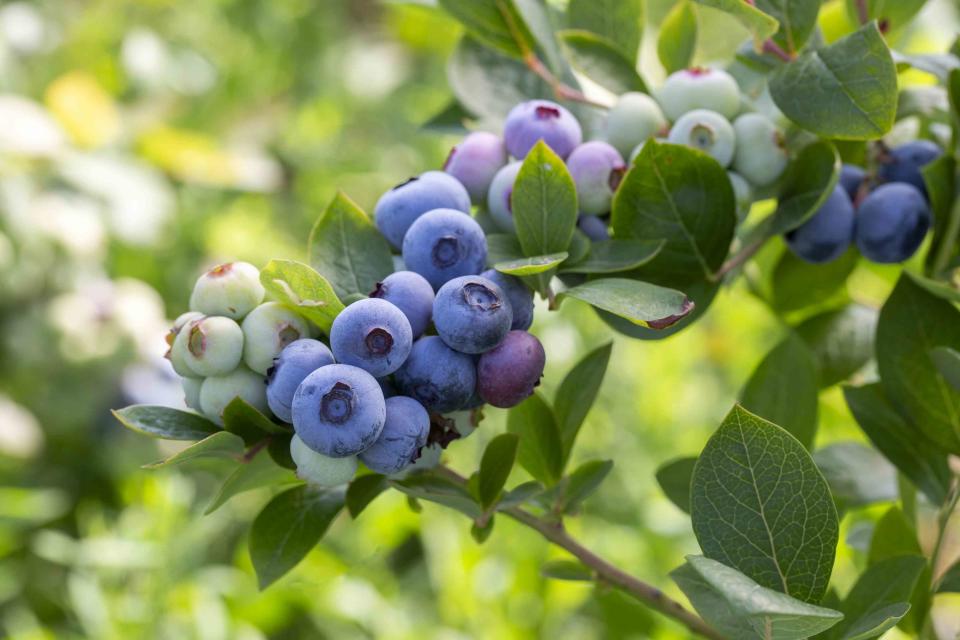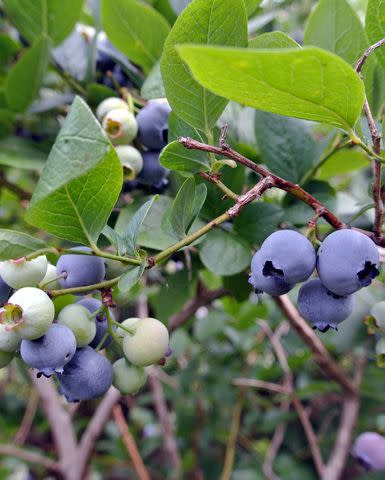How to Grow Delicious Blueberries You Can Harvest Year After Year
This easy-to-grow bush can be planted in the ground or in containers.

Esin Deniz / Getty Images
Blueberries are easy to grow in your garden or in containers. The perennial plant produces a delicious harvest year after year, so you can enjoy the fruit for more than just one season. Keep in mind that you never want to plant just one blueberry bush—having multiple will often result in a better berry. Spread out your harvest by selecting early-mid and late-season bearing varieties. Ahead, we spoke to two horticulture experts to walk us through how to grow and care for blueberries to guarantee a fruitful harvest.
Meet the Expert
Sally McCabe, associate director of community education for the Pennsylvania Horticultural Society
Jim Putnam, expert for Southern Living Plant Collection and host of HortTube.
Related: How to Plant a Sustainable Food Forest That Yields Layers of Produce
When to Plant Blueberries
It's typically best to plant blueberries when they're dormant or when the weather is less extreme. "Fall or early spring is ideal for planting blueberries outdoors in most climates," says Sally McCabe, associate director of community education for the Pennsylvania Horticultural Society, adding that summer is the worst time.
Varieties of Blueberries
Blueberry varieties differ in terms of how many chill hours (the number of hours in wintertime when your temperature is at or below 45 degrees Fahrenheit) are needed to produce fruit, as well as the plant’s heat tolerance. "Depending on your specific location and climate within the U.S., you’ll want to select a variety that will work best for your area, then follow the plant’s tag and the guidance of your local nursery or extension agency to learn the ideal time to plant," says Jim Putnam, expert for Southern Living Plant Collection and host of HortTube.
It's best to grow more than one type of blueberry variety on your property so that local pollinators can cross-pollinate them, increasing the overall fruit set. "Even if a variety is labeled as self-pollinating, having multiple varieties will often result in a better berry," says Putnam.
Here are some popular varieties of blueberries to grow:
Bush Blueberries: Bush blueberries have a compact growing habit and are typically 3 to 4 feet tall at maturity. This variety produces smaller berries and is a good option for growing in containers, says McCabe.
Northern Highbush Blueberry: This is the most common grocery store blueberry. Of the varieties that grow in North America, this type yields the biggest berries with the most fruit per plant. They have high chill hour requirements, often requiring 800 hours or more, says Putnam.
Southern Highbush Blueberries: This variety is appealing for its low chill hour requirements, some needing just 150 chill hours, says Putnam. Other varieties need slightly more (400-500), but provide large bounties of medium-sized firm berries.
Rabbiteye Blueberries: This variety is heat-tolerant and typically ripens later in summer, from July to August, says McCabe. It produces tart, delicious berries.
Related: Blueberries Really Are a Superfood—Here's What Makes Them So Good for You
How to Plant Blueberries
Make sure your soil is compatible with blueberries before planting them outside. "If you have sandy soil, amend with peat moss," says Putnam. "For clay, use pine bark soil conditioner to improve drainage."
Dig a hole that's about two times as deep and wide as the rootball.
Place the plant into the hole.
Pull amended soil around the edge of the plant and tamp down with your foot.
Apply 3 to 4 inches of mulch around the plant, leaving space at the base of the bush.
Run water at a trickle and saturate the plant. Let your newly planted shrub dry out before watering again.
Growing Blueberries in Containers
Growing blueberries in containers is a great solution if you live in a part of the country that doesn’t have acidic soil. Good drainage is essential when growing blueberries in containers. "Ensure your pot has adequate drainage holes so water doesn't linger and contribute to root rot," says Putnam.
Choose a container about 16 to 20 inches big for the plant's early years. As it matures, move it to a 24-inch container, which will allow your blueberry plant to grow with age, says Putnam. Regularly check your plants' moisture levels to ensure the soil doesn't dry out to the point of drought damage.
Add pine bark conditioner to the bottom of the pot.
Remove your blueberry from its nursery pot.
Gently loosen up the edge of the root ball to ensure it isn’t root-bound when planted.
Once the blueberry is in the container, continue to add peat moss and pine bark conditioner mix.
Cover the top of the root ball with a deep layer of soil, avoiding covering any of the woody bark.
Add fertilizer suitable for acid-loving plants, then water.

Martha Stewart
How to Care for Blueberries
Blueberries are relatively low-maintenance, but need proper growing conditions in order to thrive.
Sunlight
Like most fruit plants, blueberries thrive when given adequate sunlight, says Putnam. Blueberries need about six to eight hours of full sun, which will ensure they provide maximum fruit.
Soil
Blueberries need well-drained, acidic soil with a pH of around 4.5 to 5.5. "Since most garden soils come in at a more neutral pH of 6 to 7, add compost that is on the woodier side," says McCabe.
Water
Water your blueberry bush well in the first year while it's getting established. "As the plant matures, it tends to have fairly low supplemental water requirements in areas that receive normal rainfall," says Putnam. For container-grown blueberries or areas that are prone to drought, check the plant often to ensure it doesn't dry out. Make sure it is adequately hydrated when the fruit is maturing in early summer.
Temperature
Blueberry production is dependent on chill hours, says Putnam. Different varieties have different chill hour requirements to produce optimal fruit, as well as specific cold hardiness and heat tolerance, so you need to select a variety that’s well-suited to your area’s average yearly climate.
Fertilizer
Fertilize blueberry plants with a slow-release fertilizer for fruiting plants in late winter or early spring before they develop their leaves for the year. "Do not fertilize near the base of the plant or the leaves—this can damage the plant," says Putnam. "Instead, apply fertilizer around the drip line, or edge of the widest branches of the plants, and about a foot outward from that."
How to Prune a Blueberry Bush
Prune your blueberry bush when the plant is dormant during colder months. "Pruning in the plant’s first year isn’t a major concern," says Putnam. "The key is to begin to pay attention to the age of the canes once the plant reaches two to three years of age and beyond."
As the canes age after several years of producing berries, they typically slow down berry production. Prune them back to encourage the development of newer canes, which produce more fruit. "The best fruit is generally on canes that are between three to six years of age," says Putnam. "Weak growth, as well as canes that are dead or damaged by winter storms, should always be removed as well."
How and When to Harvest Blueberries
Observe the color of your blueberries to determine when they’re ready to pick. "When the berries begin to turn blue or purple, they’re nearing ready to go," says Putnam. "If possible, let them linger on the plant for a few days once turning blue to improve their sweetness." To harvest, simply pick the berries off the branches they're growing on.
Common Problems When Growing Blueberries
The biggest problem you'll encounter when growing blueberries is birds. "Netting or noise-making machines are common tools for protecting your harvest from birds," says Putnam. (Always monitor garden netting closely to ensure that wildlife does not get entangled.) "As far as diseases go, blueberries are extremely susceptible to root rot, so they should be planted higher up in the ground." Making sure your soil is well-draining and waiting for the soil to dry out slightly between waterings will also help protect the plant from root rot.
Related: Your Complete Guide to Growing Ground Cherries
Read the original article on Martha Stewart.

